Places to Visit in Sarnath: The Buddhist Circuit

The mystical region of Sarnath provides visitors the opportunity to explore both the spiritual, cultural and natural heritage of India. Situated along the banks of the Ganges River just north of the bustling streets of Varanasi, Sarnath provides a sanctuary, especially for travelers looking to experience India’s rich traditions. The region also attracts tourists due to its fascinating geography, architecture and history. The architectural heritage of Sarnath is apparent in the many ruins, monasteries, stupas and temples, and the top places to visit in Sarnath include many of these ancient structures. Discover more about why Sarnath is a major site on the Buddhist Circuit, along with the most recommended things to do while in the region.
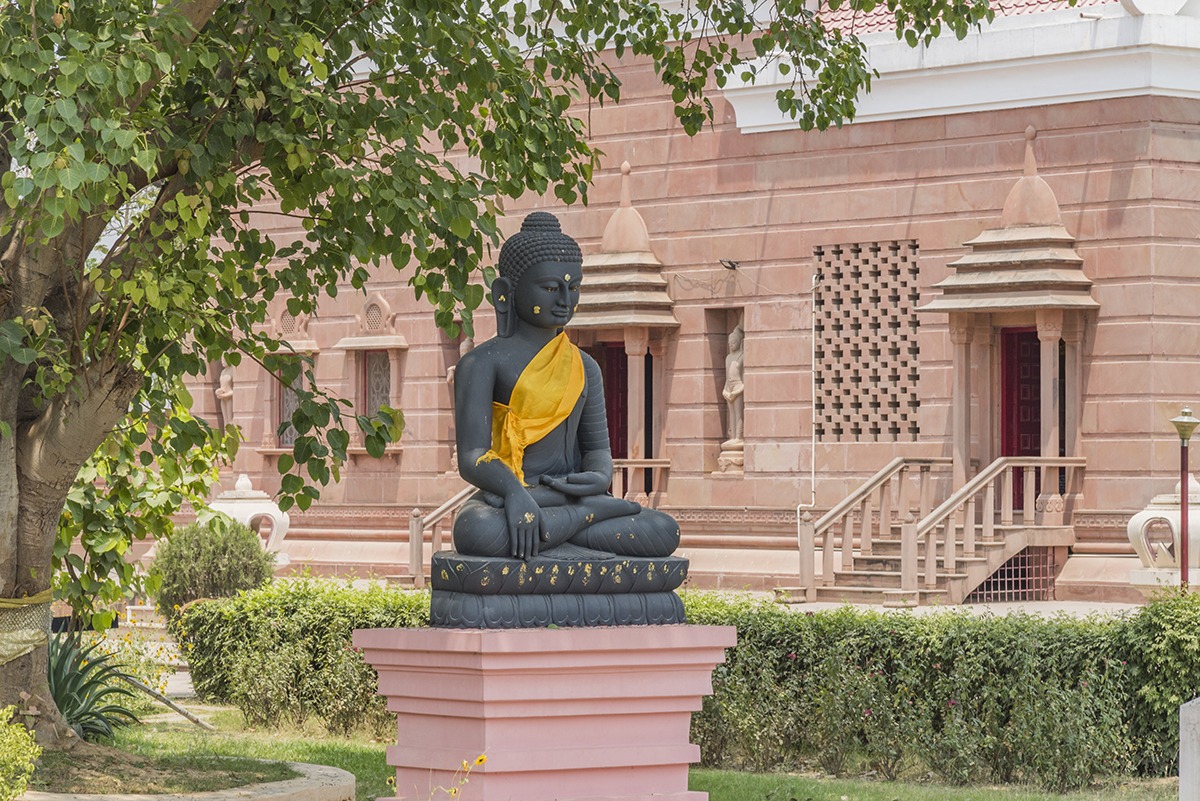
Introduction to Sarnath as Part of the Buddhist Circuit
Known as the place where Buddha delivered his first sermon to his five disciples after attaining enlightenment, Sarnath holds a profound historical and spiritual significance for Buddhists. It is a major site on the Buddhist Circuit and one of the most important Buddhist pilgrimage sites in India. The area contains several ancient structures and artifacts preserved since Buddha traveled through the region. Visitors making pilgrimages will find open meditation spaces and places to reflect on their spirituality, while tourists can admire ancient architecture and soak up the historical energy that Sarnath exudes.
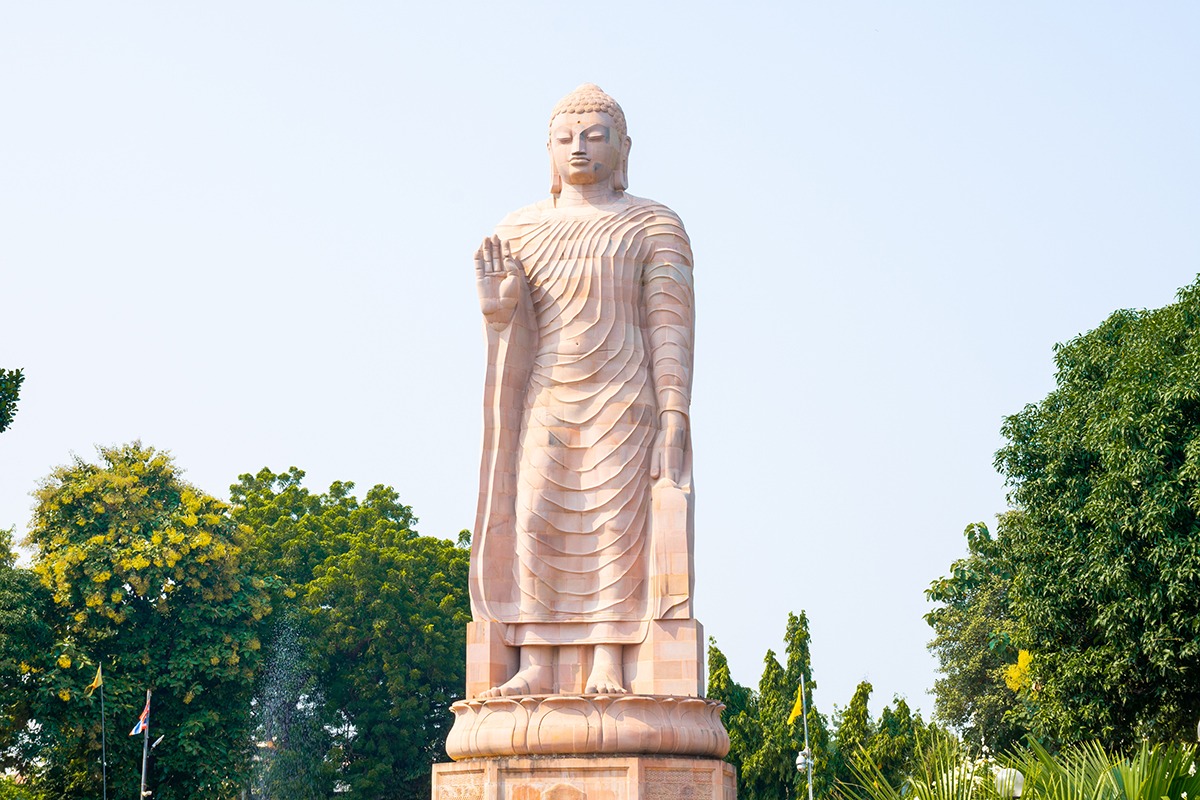
Sarnath Importance and Places to Visit
Sarnath is a treasure trove of historical artifacts. A few must-see places to visit in Sarnath include Dhamekh Stupa, Sarnath Archaeological Museum and Chaukhandi Stupa. Not only do these landmarks feature panoramic views of the landscape, but they also provide insights into Buddhist culture and opportunities for meditation. Exploring ancient ruins of monasteries and stupas adds a historical dimension to a pilgrimage to Sarnath. Together, the following places to visit in Sarnath create an itinerary that is complete with spirituality, culture and history.
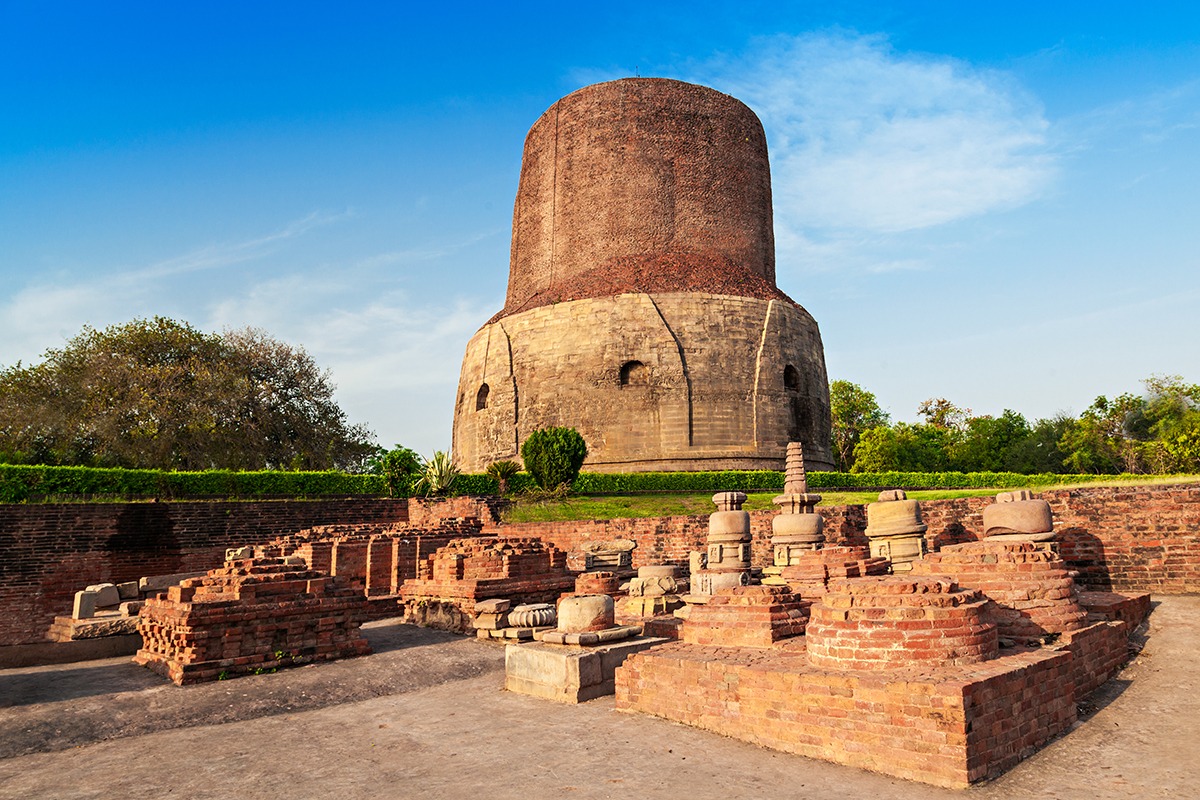
Dhamekh Stupa
The dominant Buddhist landmark in Sarnath, Dhamekh Stupa marks the location where Buddha delivered his first sermon. The event is considered a pivotal point in the development of Buddhism, and the stupa stands as a representation of Lord Buddha’s own transformation. Dhamekh Stupa towers over the region at 143 feet (43.6 meters) and is 92 feet (28 meters) in circumference. The red brick and stone structure is covered in intricate carvings that depict scenes from Buddha’s life. Dhamekh Stupa is a significant pilgrimage site for Buddhists and a major stopping spot on the Buddhist Circuit. Pilgrims pay their respects to Buddha at the stupa by offering prayers and meditating. Buddhist ceremonies and rituals also are conducted at the site, making it a hub of spiritual activity and devotion.
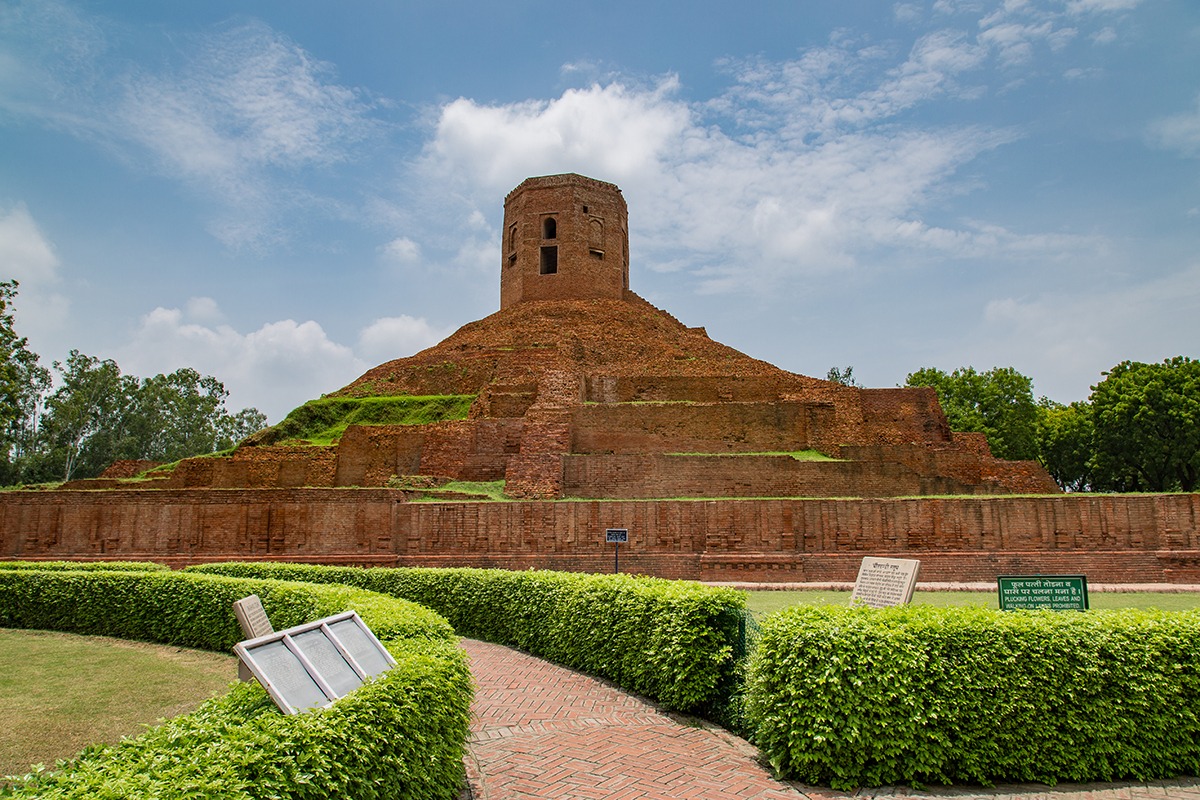
Chaukhandi Stupa
Chaukhandi Stupa is a captivating destination for pilgrims and tourists interested in exploring the roots of Buddhism and the evolution of the region’s culture. Visitors can immerse themselves in the tranquil atmosphere surrounding this ancient monument that represents the place where Buddha met his disciples upon arriving in Sarnath after his enlightenment. It also symbolizes the beginning of Buddha’s teaching of the Dharma, or the Four Noble Truths of Buddhism. The stupa’s distinctive architectural style of both Buddhist and Islamic elements sets it apart from other landmark structures in the region. The monument, built in the fifth century, symbolizes the evolution of art and culture that took place in Sarnath following Buddha’s presence. Visitors are welcome to climb the stupa to enjoy a panoramic view of Sarnath’s lush landscape and the Ganges River.
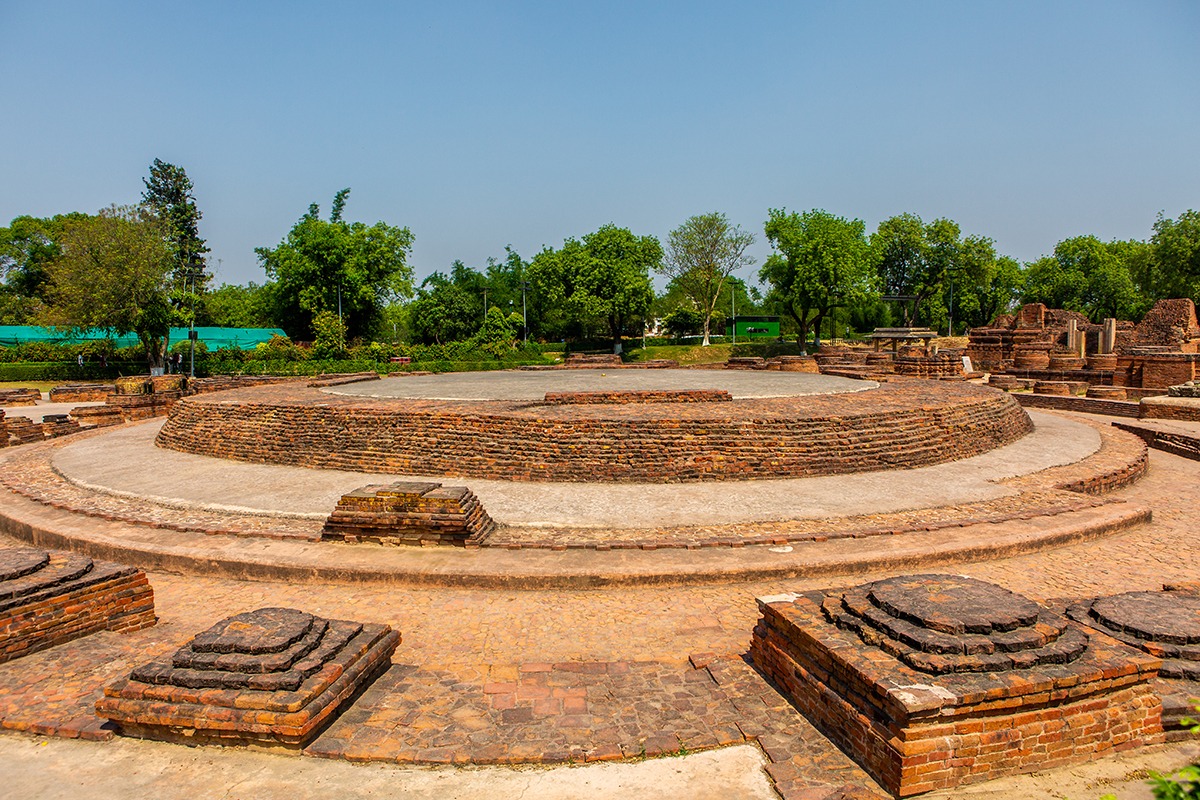
Dharmarajika Stupa
The Dharmarajika Stupa, also known as the Dharmarajika Buddhist Stupa, is a one of Sarnath’s most significant ancient landmarks. The stupa dates to the third century and is believed to contain relics of Buddha after his cremation. The foundation was laid by King Ashoka, a prominent promoter and supporter of Buddhism. The circular stone and brick frame followed traditional architecture of the time, featuring a square base and dome on top. While the stupa is largely in ruins, even after several renovations and complete reconstructions, it is believed to have stood much taller than its present height. Only remnants of the original stone railing that once surrounded the stupa remain. The Dharmarajika Stupa is part of the Archaeological Buddhist Remains of Sarnath and the Sarnath Museum. Entry hours are 10 a.m. to 5 p.m. Saturday through Thursday. The museum is closed on Friday. Ticket prices vary according to citizenship and cash payments.
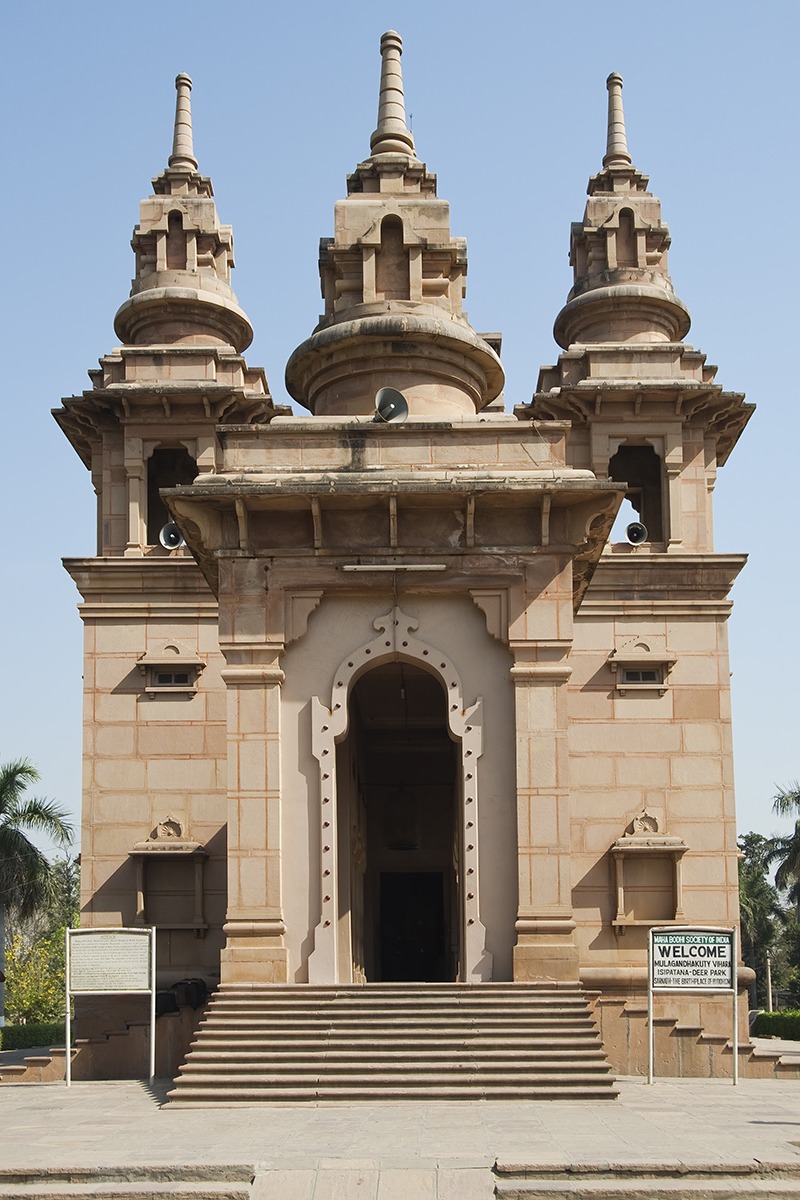
Mulagandha Kuti Vihar
Known for its enchanting frescoes and tranquil walking paths, Mulagandha Kuti Vihar is a Buddhist temple and monastery in Sarnath, India. The complex was built in 1931 by members of the Maha Bodhi Society to commemorate Buddha’s original teachings. Since then, the grounds have remained a center for learning and a popular pilgrimage site for Buddhists seeking deeper spiritual connections. One of the highlights of the temple is the wall frescoes that depict important events in the life of Buddha. Scenes from Buddha’s previous lives also are visualized in the drawings. The temple itself is designed in traditional Buddhist architecture, with Indian and Tibetan elements blended into the artwork. Mulagandha Kuti Vihar consists of meditation halls, prayer rooms and landscaped gardens, giving visitors plenty of space and freedom to contemplate on their own, but visitor also can join resident monks in meditation and worship practices daily.
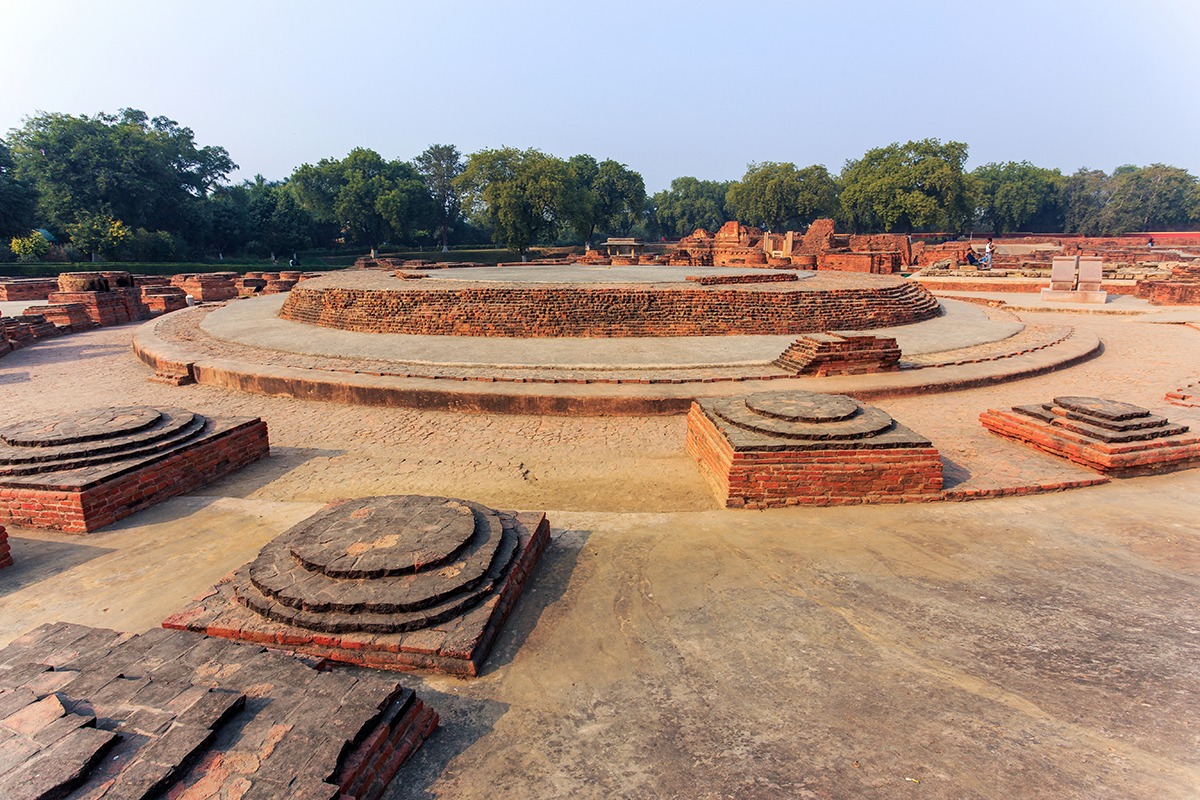
Sarnath Buddhist Complex and Archaeological Site
Many of Sarnath’s most historical structures are enclosed in the Sarnath Buddhist Complex, a UNESCO World Heritage Site. The archaeological compound houses the area’s most notable stupas, monasteries, temples and ruins. Some can’t-miss places to visit in Sarnath Buddhist Complex include Dhamekh Stupa, Chaukhandi Stupa and Mulagandha Kuti Vihar. Sarnath Archaeological Museum, also within the complex, features a vast collection of Buddhist artifacts and sculptures excavated from the sites. The Sarnath Museum is open from 9 a.m. to 5 p.m. daily, except for Fridays. The compound is closed on Fridays. The entry fee is 5 INR.
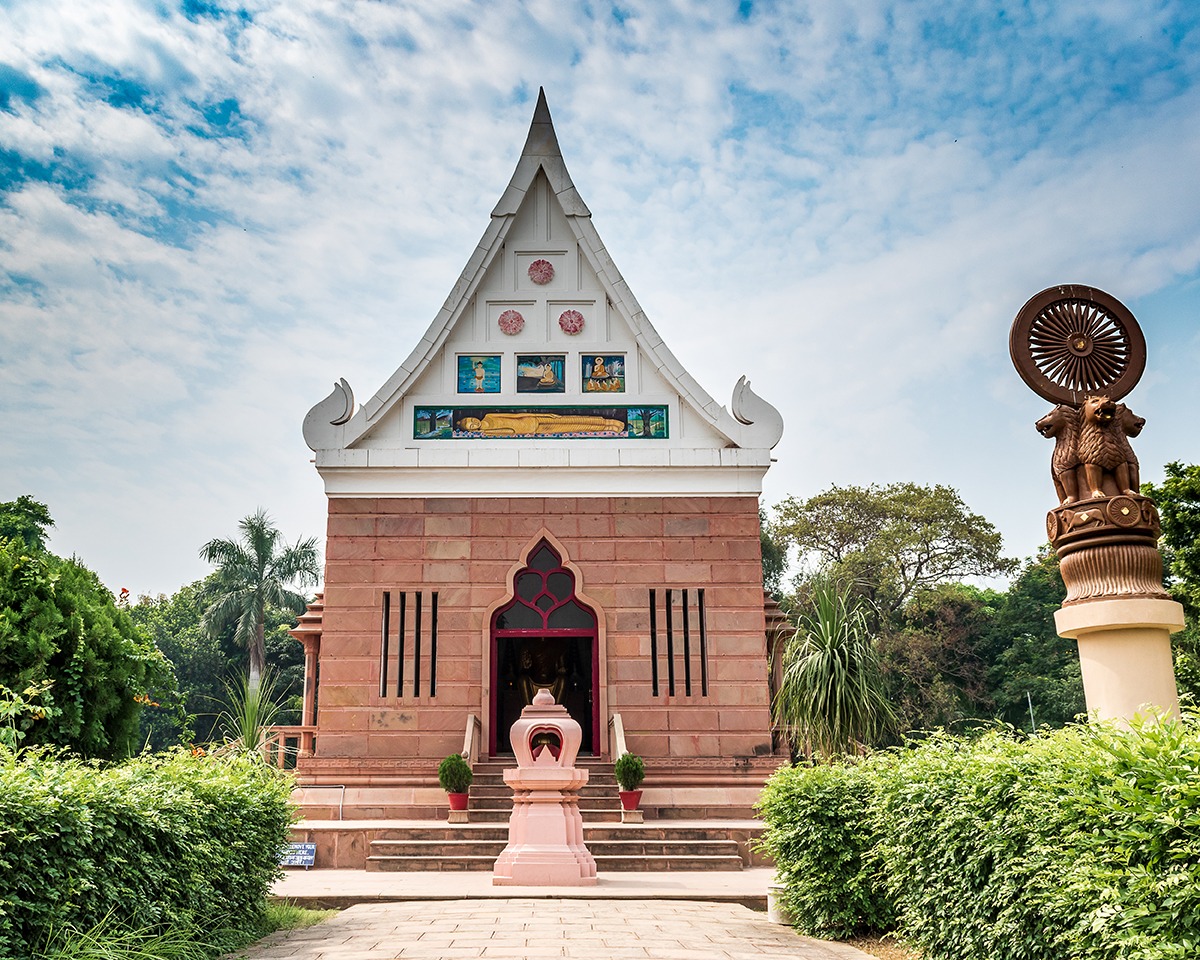
Ashokan Pillar
Erected by Emperor Ashoka in the third century, the Ashokan Pillar in Sarnath represents the pivotal role Ashoka played in the establishment and spread of Buddhism. Historically, Ashoka is one of India’s most beloved ancient rulers, as he embraced Buddha’s teaching after experience great grief about his role in the Kalinga War. Depicting a lion, the pillar was built as a place for Ashoka to inscribe his political and religious beliefs and philosophies. Now, the iconic lion is one of the most recognizable symbols in India, as the Lion Capital of Ashoka is the country’s official emblem.

Garden of Spiritual Wisdom
The sprawling grounds of the Garden of Spiritual Wisdom serve as the backdrop for Chaukhandi Stupa, the place where Buddha first met with his disciples after attaining enlightenment. While the garden is not part of the Buddhist Circuit directly, it offers pilgrims a captivating atmosphere in which to meditate and observe Buddha’s teachings. Tranquil pathways pass by spiritual sculptures that help guide visitors searching for inner peace. The garden is free to enter and open to the public from 8 a.m. to 6:30 p.m. daily.
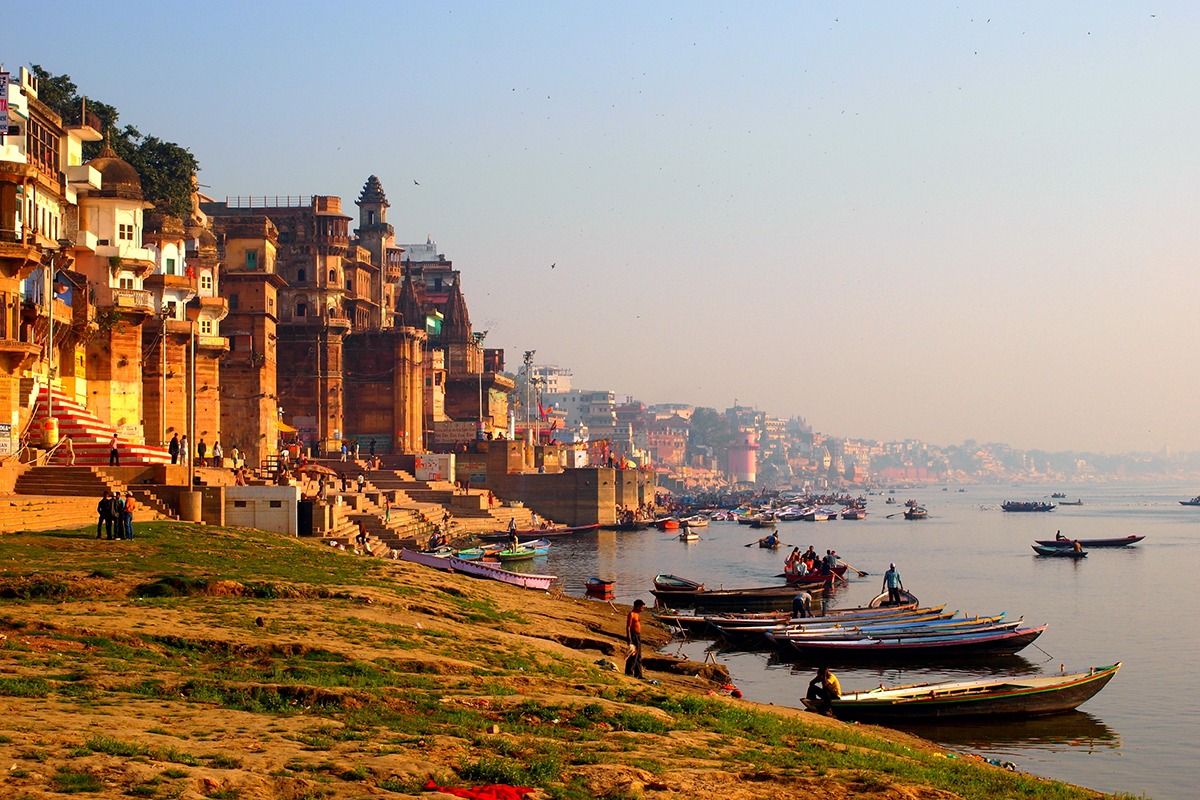
Varanasi, Ganges River & Dashashwanedh Ghat
The bustling city of Varanasi may be known worldwide due to its position along the banks of the famous Ganges River, but as the spiritual and cultural capital of India, this city has some serious tourist attractions. Varanasi is one of the oldest continuously inhabited cities in the world and serves as a prominent pilgrimage destination for Hindus. Varanasi is believed to be the home of Lord Shiva and the holiest of the seven sacred cities in Hinduism. Pilgrims and tourists alike visit Varanasi for its Banarasi silk, Muslin fabrics and ivory creations, as well as for its numerous ancient temples, ashrams and ghats, or stone steps leading to the Ganges River. Consider the following things to do while exploring the vibrant culture, narrow lanes and traditional Indian art scene that make up Varanasi.
- Take a boat ride down or bathe in the Ganges – the Ganges River serves as a source of life for many pilgrims. Along the banks, visitors can witness rituals and devotions. Many pilgrims and tourists come to the river’s edge to bathe, perform religious ceremonies and release cremated remains into the water.
- Tour Ramnagar Fort – open from 9:30 a.m. to 5:30 p.m. daily, this sandstone fort is free to explore. The royal residence and museum feature vintage cars and even a whole armory.
- Visit Kashi Vishwanath Temple – this ancient riverside temple is cherished for its gold-plated spire and sacred water well. It is open from 6 a.m. to 6 p.m. every day except Sunday.
- Catch a sunset along the ghats – partake in a mesmerizing and spiritual experience by watching the sun descend over the sacred Ganges River. The famous golden glow is what holiday fairytales are made of.
- Attend an evening Aarti ceremony at Dashashwamedh Ghat – the Aarti, or dance of fire and devotion, symbolizes the transition from day to night, so it’s no surprise that an Aarti ceremony starts at dawn. One of the most colorful and spiritually uplifting Aartis in India takes place along the Ganges River at Dashashwamedh Ghat, the most famous of the 84 ghats along the Ganges.
- Visit the weavers’ village of Sarai Mohana – here is where the ancient art of silk weaving comes alive! This quaint village nestled on the outskirts of Varanasi uses centuries-old traditions to create some of the world’s most exquisite silk fabrics, particularly Banarasi sarees. For an authentic local experience and a testament to India’s skilled craftsman, a visit to Sarai Mohana is a must.
- Join a sightseeing group tour of Sarnath – for a glimpse of a major site along the Buddhist Circuit, book a day tour from Varanasi to Sarnath. The region is one of the most important holy lands in the world, as it represents the place where Buddha delivered his first sermon following his enlightenment. It is said that Buddha walked the lands of Sarnath with his five disciples. Many artifacts and relics, as well as ancient architecture and historical remains, can be enjoyed during a tour of Sarnath.
- Explore Indian history at Bharat Kala Bhavan Museum – within the sprawling campus of Banaras Hindu University in Varanasi lies a treasure trove of art, culture and history. This remarkable museum houses a diverse and extensive collection of artifacts, sculptures, paintings and textiles that showcase the rich and multifaceted heritage of India. The museum’s galleries offer a fascinating journey through time, with exhibits that span from ancient archaeological finds to contemporary art. The museum is open from 10:30 a.m. to 4:30 p.m. Monday through Saturday. Hours are 10:30 a.m. to 4 p.m. on Sunday. Entry fees are 10 INR for Indian citizens and 100 INR for foreigners.
- Shop at a local market – head to Vishwanath Galli to find souvenirs, authentic Indian saris, handmade jewelry, religious artifacts and more at some of the city’s most popular local markets. Godowlia Market is one of Varanasi’s oldest market places, and Thateri Bazaar and Varanasi Silk Emporium deserve a browse as well. For more modern shopping experiences, check out JHV Mall and IP Sigra Mall.
- Eat a famous Varanasi snow cone – or snack on roasted peanuts or pani puri or kachoris or … the possibilities are endless! Head to the ghats for charming rooftop restaurants that serve up favorites like Banasari paan, or betel leaf-wrapped goodness, and baati chokha, a regional specialty that combines mashed vegetables with roasted wheat.
You may also like
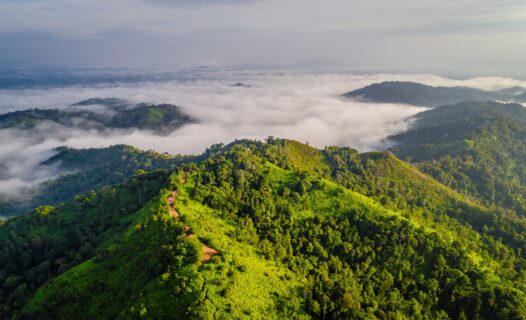
Unlock the secrets of Kuantan with a local's guide to the best day trips around the city. Explore hidden beaches, lush jungles, and rich cultural sites for an unforgettable Malaysian adventure.

Embark on an eco-friendly journey through Cameron Highlands, where verdant tea plantations, misty forests, and sustainable practices await. Discover serene landscapes, engage in conservation efforts, and immerse yourself in the local culture.
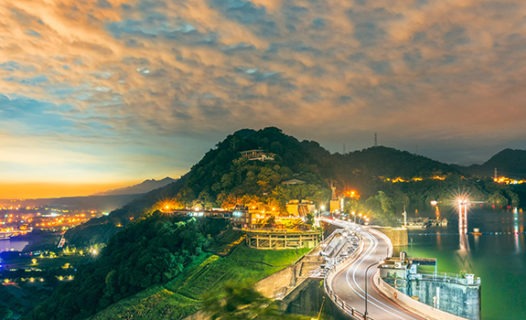
Discover Taoyuan: A hidden gem of Taiwan blending ancient heritage with modern marvels. Explore serene landscapes, thrill-packed parks, and culinary delights in our day-by-day travel guide.

Embark on a vibrant journey through Hualien, Taiwan, with our ultimate travel guide. From thrilling night market adventures to serene natural escapes and cultural explorations, discover the essence of Hualien and create unforgettable memories.

Discover the enchanting blend of traditional crafts and modern finds in our Ultimate Guide to Shopping in Fujikawaguchiko. Explore artisanal shops, local markets, and unique souvenirs against the majestic backdrop of Mount Fuji.
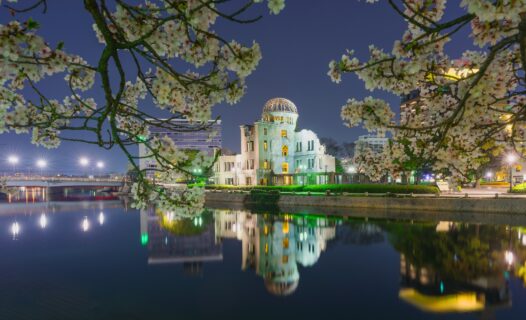
Dive into our 4-day Hiroshima travel guide, exploring iconic sites, hidden gems, and culinary delights. From the Peace Memorial Park to quaint streets of Onomichi, discover the vibrant spirit and serene beauty of Hiroshima.

Embark on a 3-day journey through Chicago's historic jazz and blues scene. From iconic clubs to live performances, discover the soul of the Windy City. Read now!

Embark on a spiritual journey with a touch of luxury. Dive into our curated guide to the most exclusive 5-star hotels in Mecca, each offering serene retreats, divine comfort, and close proximity to the Holy Mosque.

Dive into Houston’s vibrant food scene with our 4-day culinary journey guide. From iconic BBQ to global cuisines, explore the tastes that make Houston a top foodie destination.
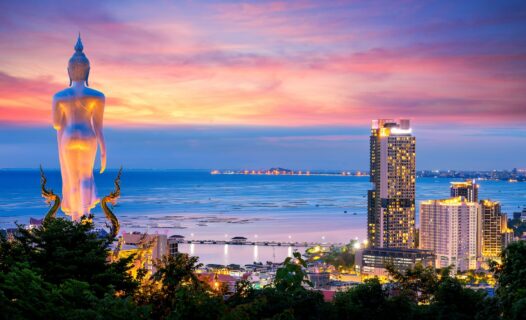
Embark on a flavorful journey through Chonburi with our Food Lover's Guide. Discover hidden culinary gems, local delicacies, and unforgettable dining experiences in Thailand's coastal paradise.

Dive into Rome's vibrant nightlife & culinary scene with our guide. From hidden wine bars to traditional eateries, taste the city's rich flavors and history.
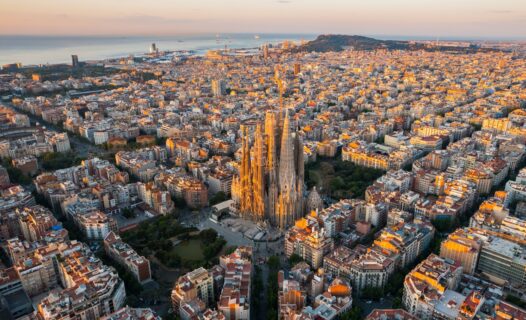
Unlock the secrets of Barcelona's most enchanting boutique hotels, where luxury meets personalized service. Explore our curated guide to discover hidden gems offering unique experiences, unmatched comfort, and a gateway into the heart of Catalonia's vibrant capital.
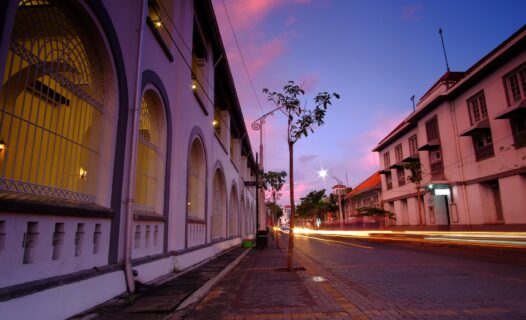
Dive into the vibrant nightlife of Semarang with our exclusive 5-night itinerary. From historic walks under the stars to beachside bars and live music venues, discover the city's best-kept secrets with Agoda.

Embark on an unforgettable journey through Melbourne with our comprehensive 3-day travel guide. From iconic laneways and street art to lush gardens and nightlife, unlock the secrets of Australia's cultural capital.

Unlock the best of Vung Tau with our guide to top waterfront hotels! Experience luxury, views, and unmatched beach access for the perfect seaside getaway.

Discover Batam Island, the hidden gem of Southeast Asia, with our ultimate travel guide. Explore pristine beaches, rich culture, culinary delights, and thrilling adventures.
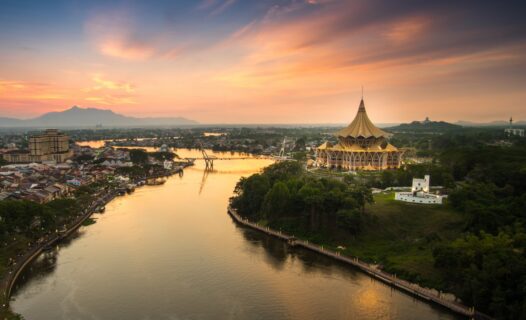
Discover Kuching: A Complete Guide to Borneo's Hidden Gem. Explore historical landmarks, vibrant cultural scenes, lush national parks, and culinary delights.

Embark on an unforgettable journey through Malang with our comprehensive travel guide. Discover the city's vibrant culture, breathtaking natural wonders, and culinary delights.

Discover the best of Kuantan in 3 unforgettable days. Dive into our guide for the ultimate itinerary covering serene beaches, rich local culture, and delicious cuisine.
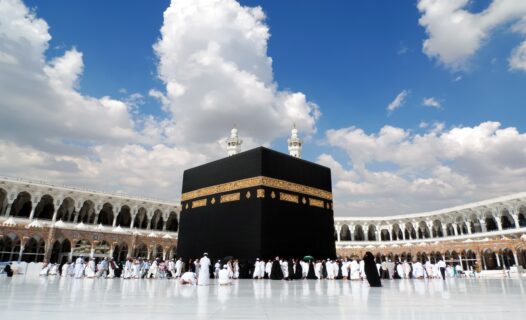
Embark on a life-changing 7-day spiritual journey in Mecca with our comprehensive guide. Discover sacred sites, enrich your faith, and immerse in Islamic culture.

Uncover the serene beauty of Cameron Highlands with our exclusive 3-day itinerary. From lush tea plantations to sweet strawberry farms and mystical hikes, embark on an unforgettable journey.

The mystical region of Sarnath provides visitors the opportunity to explore both the spiritual, cultural and natural heritage of India. Situated along the banks of the Ganges River just north of the bustling streets of Varanasi, Sarnath provides a sanctuary, especially for travelers looking to experience India’s rich traditions. The region also attracts tourists due to its fascinating geography, architecture and history. The architectural heritage of Sarnath is apparent in the many ruins, monasteries, stupas and temples, and the top places to visit in Sarnath include many of these ancient structures. Discover more about why Sarnath is a major site on the Buddhist Circuit, along with the most recommended things to do while in the region.

Introduction to Sarnath as Part of the Buddhist Circuit
Known as the place where Buddha delivered his first sermon to his five disciples after attaining enlightenment, Sarnath holds a profound historical and spiritual significance for Buddhists. It is a major site on the Buddhist Circuit and one of the most important Buddhist pilgrimage sites in India. The area contains several ancient structures and artifacts preserved since Buddha traveled through the region. Visitors making pilgrimages will find open meditation spaces and places to reflect on their spirituality, while tourists can admire ancient architecture and soak up the historical energy that Sarnath exudes.

Sarnath Importance and Places to Visit
Sarnath is a treasure trove of historical artifacts. A few must-see places to visit in Sarnath include Dhamekh Stupa, Sarnath Archaeological Museum and Chaukhandi Stupa. Not only do these landmarks feature panoramic views of the landscape, but they also provide insights into Buddhist culture and opportunities for meditation. Exploring ancient ruins of monasteries and stupas adds a historical dimension to a pilgrimage to Sarnath. Together, the following places to visit in Sarnath create an itinerary that is complete with spirituality, culture and history.

Dhamekh Stupa
The dominant Buddhist landmark in Sarnath, Dhamekh Stupa marks the location where Buddha delivered his first sermon. The event is considered a pivotal point in the development of Buddhism, and the stupa stands as a representation of Lord Buddha’s own transformation. Dhamekh Stupa towers over the region at 143 feet (43.6 meters) and is 92 feet (28 meters) in circumference. The red brick and stone structure is covered in intricate carvings that depict scenes from Buddha’s life. Dhamekh Stupa is a significant pilgrimage site for Buddhists and a major stopping spot on the Buddhist Circuit. Pilgrims pay their respects to Buddha at the stupa by offering prayers and meditating. Buddhist ceremonies and rituals also are conducted at the site, making it a hub of spiritual activity and devotion.

Chaukhandi Stupa
Chaukhandi Stupa is a captivating destination for pilgrims and tourists interested in exploring the roots of Buddhism and the evolution of the region’s culture. Visitors can immerse themselves in the tranquil atmosphere surrounding this ancient monument that represents the place where Buddha met his disciples upon arriving in Sarnath after his enlightenment. It also symbolizes the beginning of Buddha’s teaching of the Dharma, or the Four Noble Truths of Buddhism. The stupa’s distinctive architectural style of both Buddhist and Islamic elements sets it apart from other landmark structures in the region. The monument, built in the fifth century, symbolizes the evolution of art and culture that took place in Sarnath following Buddha’s presence. Visitors are welcome to climb the stupa to enjoy a panoramic view of Sarnath’s lush landscape and the Ganges River.

Dharmarajika Stupa
The Dharmarajika Stupa, also known as the Dharmarajika Buddhist Stupa, is a one of Sarnath’s most significant ancient landmarks. The stupa dates to the third century and is believed to contain relics of Buddha after his cremation. The foundation was laid by King Ashoka, a prominent promoter and supporter of Buddhism. The circular stone and brick frame followed traditional architecture of the time, featuring a square base and dome on top. While the stupa is largely in ruins, even after several renovations and complete reconstructions, it is believed to have stood much taller than its present height. Only remnants of the original stone railing that once surrounded the stupa remain. The Dharmarajika Stupa is part of the Archaeological Buddhist Remains of Sarnath and the Sarnath Museum. Entry hours are 10 a.m. to 5 p.m. Saturday through Thursday. The museum is closed on Friday. Ticket prices vary according to citizenship and cash payments.

Mulagandha Kuti Vihar
Known for its enchanting frescoes and tranquil walking paths, Mulagandha Kuti Vihar is a Buddhist temple and monastery in Sarnath, India. The complex was built in 1931 by members of the Maha Bodhi Society to commemorate Buddha’s original teachings. Since then, the grounds have remained a center for learning and a popular pilgrimage site for Buddhists seeking deeper spiritual connections. One of the highlights of the temple is the wall frescoes that depict important events in the life of Buddha. Scenes from Buddha’s previous lives also are visualized in the drawings. The temple itself is designed in traditional Buddhist architecture, with Indian and Tibetan elements blended into the artwork. Mulagandha Kuti Vihar consists of meditation halls, prayer rooms and landscaped gardens, giving visitors plenty of space and freedom to contemplate on their own, but visitor also can join resident monks in meditation and worship practices daily.

Sarnath Buddhist Complex and Archaeological Site
Many of Sarnath’s most historical structures are enclosed in the Sarnath Buddhist Complex, a UNESCO World Heritage Site. The archaeological compound houses the area’s most notable stupas, monasteries, temples and ruins. Some can’t-miss places to visit in Sarnath Buddhist Complex include Dhamekh Stupa, Chaukhandi Stupa and Mulagandha Kuti Vihar. Sarnath Archaeological Museum, also within the complex, features a vast collection of Buddhist artifacts and sculptures excavated from the sites. The Sarnath Museum is open from 9 a.m. to 5 p.m. daily, except for Fridays. The compound is closed on Fridays. The entry fee is 5 INR.

Ashokan Pillar
Erected by Emperor Ashoka in the third century, the Ashokan Pillar in Sarnath represents the pivotal role Ashoka played in the establishment and spread of Buddhism. Historically, Ashoka is one of India’s most beloved ancient rulers, as he embraced Buddha’s teaching after experience great grief about his role in the Kalinga War. Depicting a lion, the pillar was built as a place for Ashoka to inscribe his political and religious beliefs and philosophies. Now, the iconic lion is one of the most recognizable symbols in India, as the Lion Capital of Ashoka is the country’s official emblem.

Garden of Spiritual Wisdom
The sprawling grounds of the Garden of Spiritual Wisdom serve as the backdrop for Chaukhandi Stupa, the place where Buddha first met with his disciples after attaining enlightenment. While the garden is not part of the Buddhist Circuit directly, it offers pilgrims a captivating atmosphere in which to meditate and observe Buddha’s teachings. Tranquil pathways pass by spiritual sculptures that help guide visitors searching for inner peace. The garden is free to enter and open to the public from 8 a.m. to 6:30 p.m. daily.

Varanasi, Ganges River & Dashashwanedh Ghat
The bustling city of Varanasi may be known worldwide due to its position along the banks of the famous Ganges River, but as the spiritual and cultural capital of India, this city has some serious tourist attractions. Varanasi is one of the oldest continuously inhabited cities in the world and serves as a prominent pilgrimage destination for Hindus. Varanasi is believed to be the home of Lord Shiva and the holiest of the seven sacred cities in Hinduism. Pilgrims and tourists alike visit Varanasi for its Banarasi silk, Muslin fabrics and ivory creations, as well as for its numerous ancient temples, ashrams and ghats, or stone steps leading to the Ganges River. Consider the following things to do while exploring the vibrant culture, narrow lanes and traditional Indian art scene that make up Varanasi.
- Take a boat ride down or bathe in the Ganges – the Ganges River serves as a source of life for many pilgrims. Along the banks, visitors can witness rituals and devotions. Many pilgrims and tourists come to the river’s edge to bathe, perform religious ceremonies and release cremated remains into the water.
- Tour Ramnagar Fort – open from 9:30 a.m. to 5:30 p.m. daily, this sandstone fort is free to explore. The royal residence and museum feature vintage cars and even a whole armory.
- Visit Kashi Vishwanath Temple – this ancient riverside temple is cherished for its gold-plated spire and sacred water well. It is open from 6 a.m. to 6 p.m. every day except Sunday.
- Catch a sunset along the ghats – partake in a mesmerizing and spiritual experience by watching the sun descend over the sacred Ganges River. The famous golden glow is what holiday fairytales are made of.
- Attend an evening Aarti ceremony at Dashashwamedh Ghat – the Aarti, or dance of fire and devotion, symbolizes the transition from day to night, so it’s no surprise that an Aarti ceremony starts at dawn. One of the most colorful and spiritually uplifting Aartis in India takes place along the Ganges River at Dashashwamedh Ghat, the most famous of the 84 ghats along the Ganges.
- Visit the weavers’ village of Sarai Mohana – here is where the ancient art of silk weaving comes alive! This quaint village nestled on the outskirts of Varanasi uses centuries-old traditions to create some of the world’s most exquisite silk fabrics, particularly Banarasi sarees. For an authentic local experience and a testament to India’s skilled craftsman, a visit to Sarai Mohana is a must.
- Join a sightseeing group tour of Sarnath – for a glimpse of a major site along the Buddhist Circuit, book a day tour from Varanasi to Sarnath. The region is one of the most important holy lands in the world, as it represents the place where Buddha delivered his first sermon following his enlightenment. It is said that Buddha walked the lands of Sarnath with his five disciples. Many artifacts and relics, as well as ancient architecture and historical remains, can be enjoyed during a tour of Sarnath.
- Explore Indian history at Bharat Kala Bhavan Museum – within the sprawling campus of Banaras Hindu University in Varanasi lies a treasure trove of art, culture and history. This remarkable museum houses a diverse and extensive collection of artifacts, sculptures, paintings and textiles that showcase the rich and multifaceted heritage of India. The museum’s galleries offer a fascinating journey through time, with exhibits that span from ancient archaeological finds to contemporary art. The museum is open from 10:30 a.m. to 4:30 p.m. Monday through Saturday. Hours are 10:30 a.m. to 4 p.m. on Sunday. Entry fees are 10 INR for Indian citizens and 100 INR for foreigners.
- Shop at a local market – head to Vishwanath Galli to find souvenirs, authentic Indian saris, handmade jewelry, religious artifacts and more at some of the city’s most popular local markets. Godowlia Market is one of Varanasi’s oldest market places, and Thateri Bazaar and Varanasi Silk Emporium deserve a browse as well. For more modern shopping experiences, check out JHV Mall and IP Sigra Mall.
- Eat a famous Varanasi snow cone – or snack on roasted peanuts or pani puri or kachoris or … the possibilities are endless! Head to the ghats for charming rooftop restaurants that serve up favorites like Banasari paan, or betel leaf-wrapped goodness, and baati chokha, a regional specialty that combines mashed vegetables with roasted wheat.
You may also like
